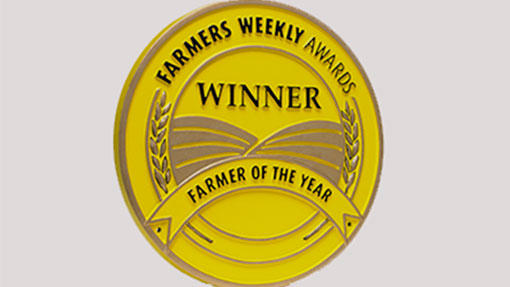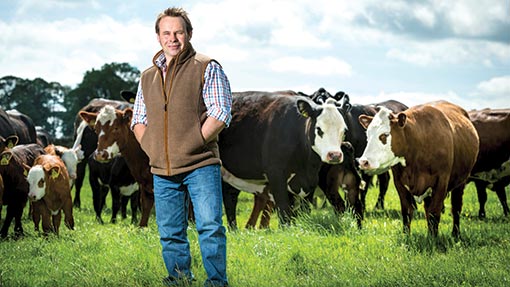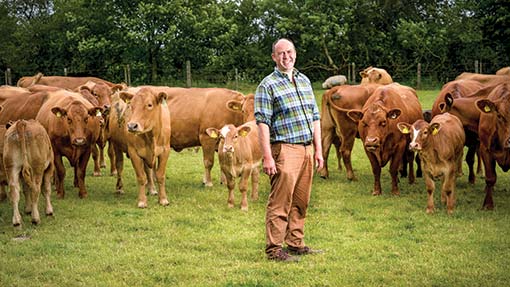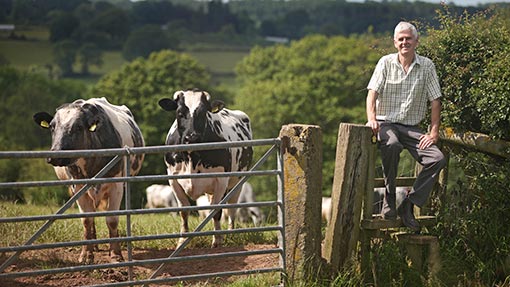2014 Farmers Weekly Beef Farmer finalists revealed

This year’s Beef Farmer of the Year finalists operate simple, yet effective systems. And while each farm is very different, all three finalists share a passion for the industry, evident through a commitment to sharing knowledge and made possible by a clear focus on ease of management.
Simon Bainbridge
Bainbridge Farms, Northumberland

The simple yet efficient nature of Simon Bainbridge’s Angus and Hereford cross-bred suckler herd is a tribute to his clear focus on forage production and fertility management.
Since returning to his home farm, Donkin Rigg, near Morpeth, two decades ago, Simon has not only grown the acreage, but the business as a whole. The biggest change was converting to organic in 2010.
“With the increased acreage I was able to produce all feed on the holding, with only minerals bought in to protect against feed cost rises.”
Every hectare has been analysed and yield mapped to aid production of high-energy, high-protein forages including red clover, lucerne, whole-crop peas and oats, undersown with high-sugar grasses.
Farm facts
- Organic upland farm, 285ha owned, 382ha tenanted from the National Trust
- 130 Angus cross Hereford suckler cow herd
- Producing home-bred replacements calving at two years old
- Steers and surplus heifers finished on a forage-based system are sold into a premium beef scheme
Forage trials
One of eight commercial development farmers for Waitrose, working on the benefits of sustainable forage production, Simon is trialling lucerne as break crop for red clover to reduce problems from eelworm nematode, with excellent results.
“This year the lucerne has been excellent, with three cuts achieving more than 18% protein,” he says.
But for Simon, red clover remains the silage crop of choice for finishing cattle and replacement in-calf heifers.
While the triumph of his forage production is evident, Simon’s choice of beef animal and continual improvement of herd genetics are pivotal to the farm’s success.
The Aberdeen Angus cross Hereford suckler cows, commonly known as the Black Baldie, specifically suit the upland farm, making good use of the grass and forage available. Cross-breeding these maximises hybrid vigour to produce cattle that can finish off grass and forage.
Simon’s calves are currently averaging 0.9kg daily liveweight gain in their first year and finish between 18 and 24 months solely on a diet of home-grown grass and forage.
“We looked at the market and Dovecote Park is on our doorstep. All cattle are finished on the holding for the premium organic native breed market. They have been paying £4.58/kg for a 300kg O4 carcass.”
Breeding policy
In his home-bred replacement heifers, Simon is aiming for sucklers of 600kg or less that produce a 300kg calf at 200 days without any creep. This requires an eye for identifying genetics that maximise grass use.
“We can expand with the right beast – one that doesn’t create work, grows well, calves easily and has milk. Last year calving assistance was only 2.5%.”
High-index bulls are selected on EBVs and looks from the top 10% of each breed (Angus and Hereford). They are specifically selected on maternal traits, positive fat, milk and easy calving.
“We’re very much doing what we want in terms of ease of calving and average growth rates, as we don’t want a huge cow. They are milky, but not too much to avoid problems with big bags.
“We want a positive fat score so they put flesh on in the summer, get in-calf and keep fit over the winter. Cattle won’t finish unless they have fat on their backs.”
Heifers selected to calve at 24 months must be 370kg at bulling, have a pelvic measurement of 140sq cm at 13 months and a quiet temperament. Any that don’t make these criteria are fattened and sold. Heifers with an Angus passport go to a Hereford bull and vice versa.
This strict selection policy leaves only fertile heifers, which take to the bull in short periods (six weeks), achieving a very tight calving pattern, with almost 60% calving in the first three weeks.
Cows must be in calf after nine weeks in with the bull or receive the same fate. All the cows receive a trace element bolus pre-calving.
Being part of the SAC Premium Cattle Health Scheme, the herd is regularly tested for bovine viral diarrhoea (BVD) and Johne’s and is vaccinated against BVD and scour.
Industry links
Since becoming one of the first monitor farms in northern England in 2010, Simon has hosted a range of on-farm events for beef farming groups and school parties.
A member of various discussion groups, including the Eblex progressive beef and sheep group, he has a strong enthusiasm for sharing knowledge. He is also chairman of his NFU branch and vice-chairman of the regional livestock board.
In the future, Simon aims to market more high health status organic heifer replacements to create a new income stream and increase profitability.
Billy O’Kane
Crebilly Farm, Ballymena, Co Antrim

A clear drive to maximise total kilos weaned a hectare has successfully boosted the productivity of Billy O’Kane’s suckler herd.
Billy, who farms with his wife Liz, has completely overhauled the herd genetics at Crebilly Farm, Ballymena, Co Antrim.
“Cow performance is the financial driving force of a suckler herd,” says Billy, who runs a fully Signet-recorded herd.
He says cows must tick many boxes for profitability, including being hybrid, fertile, easy calving, efficient forage users and of moderate mature weight.
Previously farming continental types, his switch to animals based on their type, rather than breed, has been key to his success. If it makes a profit, Billy would keep it. And he believes he’s found his closest match in the Stabiliser.
With similar growth rates as some continentals, but 20% lower food intake, plus being a dedicated maternal breed that would calve outside, the Stabiliser fits well with his drive for profit and move towards an easy calving system.
“I’m hung up on cow type, that’s what changed my life financially. We’re getting lower birth weights [38kg], but the same growth rate [364kg bull carcass weight at 13.8 months old] due to focus on breed improvement and better forage use.
“The Stabiliser is a ranching breed, designed for minimum supervision and outdoor calving, so it’s best treated as such.”
Farm facts
- 121ha owned, 81ha rented
- 145 Stabiliser composite suckler herd
- Sells surplus heifer replacements and breeding bulls
- Any not up to spec are fattened
- One-third of farm area is in the NI Countryside Management Scheme
Breeding
Heifer selection is done through a combination of EBVs, growth rates, visual appearance and dam history.
“EBVs are not the be all and end all – a cow must be structurally functional, with good feet, teats and temper – but they are an extremely good start. We place high emphasis on maternal production value.”
Billy calves his heifers at two years old, which he credits with creating almost £50 a cow a year additional net profit, compared with calving at three years old.
And the decrease in mature cow weaning weight from 750kg to 620kg has allowed him to keep 14% more cows on the same acreage, with no knock-on effect on calf size.
Billy spends a lot of time selecting sires. Of the five stock bulls, all are in the top 1% for beef value, are positive for milk and in the top 5% for maternal production value.
“It has taken a major change in mindset from the past, where we chose a bull on visual aesthetics, to nowadays, where financial drivers such as EBVs for calving value, milk, and udder and teat size are key factors to allow us to breed efficient, medium-bodied cows.”
Performance
Since the overhaul, significant improvements have been made. Conception rates are 98% over a 12-week service period and assisted births have dropped to just 2%.
Calving interval has tightened from 391 to 361 days, and calves weaned for every 100 cows bulled has risen by 13 to 96 for the past five years running.
All this has led to an impressive 32% increase in calf kilos weaned a hectare.
An integral part of the business is breeding sales, which are supported through an advisory service where Billy shares his knowledge so customers can hopefully reach the same financial performance he has seen.
Billy believes there’s strength in numbers and works closely with local farmers. He has formed a group selling bull beef and receives a 5p/kg premium from the abattoir for these larger volumes.
Most recently he has formed a buying group through which he has successfully reduced the price of bought-in feed by £10-15/t.
Alongside this, being a monitor farmer is helping him improve grassland management, including the successful introduction of clover into grass leys, yielding 14t DM/ha with just 173 units N/ha.
In the future, Billy’s ambitions are to further improve his grassland management through increased soil aeration and clover use and capitalise on the work being done on net feed efficiency.
Mervyn Thomas
Hollingwood Farm, Herefordshire

Mervyn Thomas is making giant strides in finishing cattle quickly and efficiently by focusing on the hybrid vigour of his three-way cross.
Despite relocating the suckler herd to Hollingwood Farm, Abbey Dore, Herefordshire, less than a year ago and more than halving farm acreage, his finishing performance continues to strengthen.
With a clear passion for his herd, devout stockman Mervyn is producing top-quality finishers.
The 32 bulls sold this year have averaged 408kg deadweight at 399 days old, with 81% graded as E or U+. Heifers averaged 311kg deadweight after 406 days for the 28 sold, with 75% graded U- or above.
One significant change Mervyn made after realising more weight was needed to make the system profitable was a switch from Limousin to high-quality Blonde D’Aquitaine bulls in 2006.
Bulls are mated with British Blue cross Holstein Friesian cows, chosen by Mervyn for their milkiness and good mothering ability, with exceptional results.
So far in 2014 the Blonde-cross bull calves are averaging 1.02kg daily carcass gain from birth to slaughter, while heifers are gaining 0.77kg/day, not including initial calf weight.
“I’m a firm believer that quality breeding stock is the foundation for a profitable beef finishing enterprise. The first Blonde-cross calves were a revelation and the dramatic improvement in herd performance gave me the courage to increase cow numbers to 100,” says Mervyn, who farms in partnership with his wife Gill.
Farm facts
- 79ha of grassland
- 100 British Blue cross Friesian cows put to Blonde bulls
- Intensively finishes all progeny for ABP in 12-14 months
Herd management
Maintaining this herd size while farming in a TB hotspot remains one of his toughest challenges, especially as replacement heifers are difficult to source.
“My biggest worry is always TB. We lost three last month and are down at the moment. I would like to source all heifers from one place for biosecurity and try to make the farm a fortress to keep badgers out by filling in all gaps in the hedges.
“Due to TB being rampant in this area, selling calves as stores would be out of the question, so all cattle are finished inside 12-14 months.”
Finishing focus
It’s visits to the abattoir that made Mervyn realise carcass weight and killing-out percentage are vital for a profitable beef enterprise.
“Most people talk about liveweight gain, I concentrate on deadweight gain a day, as that’s what we get paid for.”
Keeping calves with their mothers until they’re nine months old has proven invaluable to fulfil calf growth rate potential using the milkiness of the two-way cross and this is reflected in impressive weaning weights. Bull calves can weigh up to 500kg and heifers weigh in at 400kg or more.
The cows are wintered on ad-lib big-bale silage, so late weaning also enables Mervyn to better manage body condition scores in the dry period while maximising calf weight gain.
Creep feed is offered from 12 weeks and continues after housing to minimise calf stress. They are weaned next to their mothers, so no growth check is seen.
Not happy with R-grades, Mervyn strives for quality as well as a quick finish, made possible by the breed choice.
Fed ad-lib, bulls and heifers eat about 2t of cake a head (14.5% protein and 13.3MJ of metabolisable energy/kg) including creep feed, plus wheat straw to slaughter at an average liveweight of 648kg and 525kg and killing out at 63.1% and 59.3%, respectively.
Health plan
Mervyn has worked hard on his herd health plan and rigorous TB testing has resulted in three separate cattle handling facilities in discrete areas of the farm to allow for easier TB testing with minimal cow movement and stress.
Working closely with his local vet, Mervyn has annual random bovine viral diarrhoea (BVD) samples taken from 10 calves and all cows are tested for Johne’s.
A comprehensive vaccination plan sees cows covered against BVD, leptospirosis and rotavirus, plus given a mineral bolus after weaning. Calves receive only a pour-on wormer after housing.
“We don’t get many visits for sick cattle and our vets have held meetings here discussing BVD, semen testing of bulls and general health issues. I try to encourage others to vaccinate and enjoy showing my herd to other farming societies.”
But it’s not just the farming fraternity Mervyn entertains. Encouraging schoolchildren and non-farming groups alike, last year he welcomed more than 250 visitors to the farm.
Sponsor’s message
 “Like McDonald’s, all three finalists understand the importance of sustainability, at the core of which is a simple, transparent supply chain providing quality ingredients. Working with visionary farmers such as these helps us to safeguard the industry for all.”/P>
“Like McDonald’s, all three finalists understand the importance of sustainability, at the core of which is a simple, transparent supply chain providing quality ingredients. Working with visionary farmers such as these helps us to safeguard the industry for all.”/P>
Warren Anderson
Vice-president, supply chain
Find out more about the 2014 Farmers Weekly Awards
